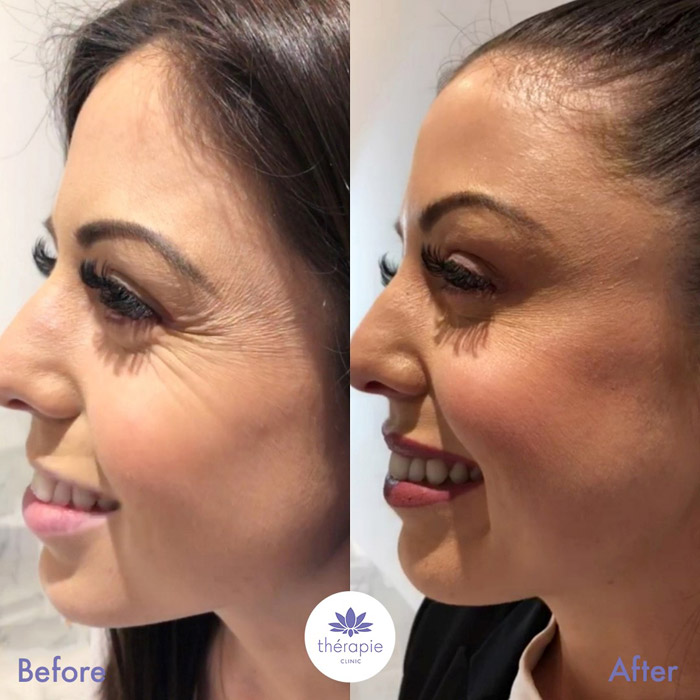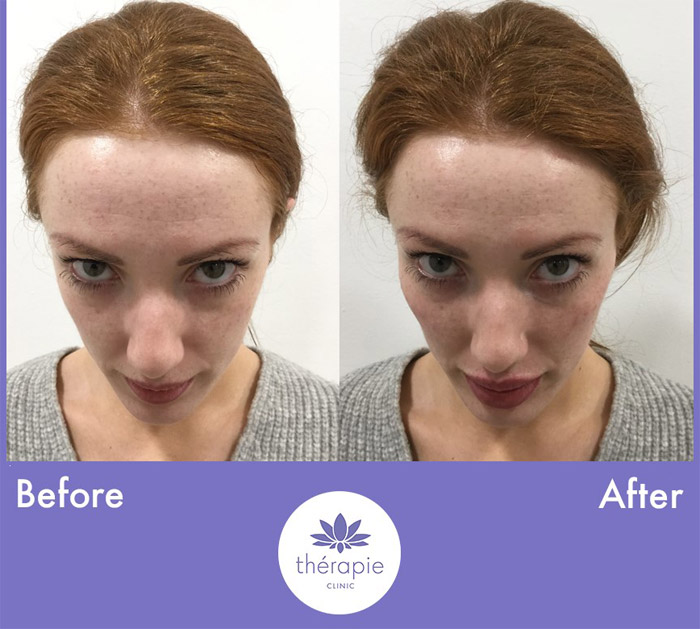What’s the difference between Botox and dermal fillers?
Botox and dermal fillers are among the most popular and sought-after cosmetic procedures for combating the appearance of wrinkles and other signs of aging in the aesthetic market today. If you are considering undergoing these injectable treatments, you may be confused between the two. They may seem similar, but in reality, they are actually quite different and tackle different issues related to aging of the skin. But don’t worry, as we are here to help you chose what treatment is right for you, and hopefully clear up any confusion!
What is Botox and how does it work?
Botox is made from a natural, purified protein, also known by its less catchy name Botulim Toxin Type A, which can help to relax facial muscles that are responsible for causing lines and wrinkles. In 2002, Botox was approved by the FDA as a cosmetic treatment for frown lines above the eyebrows, and on the forehead and wrinkles around the eye area, or “crows feet”. Botox is injected into localised areas of the skin in extremely small concentrations and it works by blocking nerve signals in the muscles where it is injected. When those nerve signals are interrupted, the affected muscle is temporarily relaxed, and the skin becomes smoother. Because the movement of these selected facial muscles if reduced, wrinkles become softer in appearance and fines lines are reduced. The result is a refreshed and well-rested look. With continued treatment, lines and wrinkles will appear less prominent with time as the muscles shrink and becoming less contracted. Botox injections can also aid in the prevention of new lines and wrinkles from developing, which is why it is also used as a preventative treatment.
Is there any downtime or side effects from Botox?
There is no real downtime associated with Botox, which is one of the reasons patients find it so appealing. You may experience some slight bruising and swelling from the needle directly after treatment, but this can easily be masked with make-up and will disappear within a couple of hours. Because the procedure is not surgical, you can resume your usual activities straight away, and you can even fly post-treatment. It is advisable to keep upright for at least 4 hours post treatment and we also recommend that you avoid exercise for 24 hours afterwards. You should be mindful of the treated area and avoid touching the area excessively.
At Thérapie Clinic, all Botox treatments are carried out by medical professionals, all of whom have a deep understanding of the underlying facial musculature and facial aesthetics, ensuring you are in safe and highly skilled hands. Our team of injectors have years of experience in delivering results that are youthful yet subtle, eliminating that “frozen” look, so you can rest assured that the results will look natural and beautiful.

When will I see the results from Botox?
The effects of Botox are not visible straight away, as it takes time for the Botox to start working and relaxing the muscles. Results vary from person to person, but in general the effects of anti-wrinkle injections will start to take effect after 2-5 days, when the muscles beneath the skin begin to relax. The best results will be visible after approximately 2-3 weeks after the injections have been administered, when lines and wrinkles will be significantly reduced. The results are subtle and natural, making you look well-rested and more youthful. At Thérapie Clinic we have an excellent after care service, which is of course included in the price. You will come back for a follow up appointment within 21 days, so we can assess the results of the treatment and adjust if necessary.
How long does Botox last?
Botox injections are not permanent, and the effects of the treatment will wear off with time. It of course varies from person to person, but most people find that the muscle-relaxing effect of Botox lasts for 3 to 6 months. Regular Botox treatments can affect how long the results lasts. In general, you will need fewer Botox treatments over time to get the same effect. Lines and wrinkles can often appear less severe with time because the muscles are shrinking.
What are dermal fillers?
Dermal fillers are used are used effectively to lift and plump the skin, to add volume and smooth out lines and wrinkles. They are used in various areas of the face such as the cheeks, around the eyes, mouth and jawline and can also be injected directly into the lips. Because our skin loses its fullness as we age due to the depletion of collagen and elastin, fillers replenish lost volume and create a more youthful appearance.
Similar to Botox, dermal fillers are injected under the skin to eliminate or prevent the visible signs of aging such as fine lines and wrinkles. However, this is where the treatments often get confused. The main difference is that Botox reduces the activity of muscles in the face that cause wrinkles. Instead of relaxing muscles, dermal fillers increase volume beneath the surface of skin. This helps your skin achieve as youthful of a look as possible, making it appear plumper and smoothing out lines and wrinkles, as well as eliminate signs of aging that occur as a result of collagen depletion.
How do dermal fillers work?
Dermal or facial fillers are injectables that contain hyaluronic acid, a molecule that is found naturally in the skin. Hyaluronic acid works as a magnet for moisture, helping your cells retain as much of it as possible so that your skin feels and appears hydrated, plump and healthy. At Thérapie Clinic we only use the world-renowned Juvederm dermal filler. A fine needle is used to inject the filler into the targeted area on the face. By injecting a hyaluronic acid dermal filler that closely resembles our own bodily hyaluronic acid deep into the skin, water will be drawn to the area, rehydrating and plumping the skin from the inside out. The result is a smooth, subtle and above all-natural look.

Is there any downtime or any side effects from dermal fillers?
There is no downtime after the treatment, however, some common injection-related reactions might occur, such as swelling, redness, pain, itching, discoloration and tenderness at the injection site. These will disappear spontaneously within 2 to 10 days, which is why it is best not to have the treatment right before an event or occasion as the area may still be swollen or red. It is recommended that you not to take anti-inflammatory drugs such as ibuprofen or aspirin in the days before your treatment as these may cause bleeding or increased bruising at the injection site. You should avoid exercise except for walking for 24 hours after the treatment.
How long do dermal fillers last?
Similar to Botox, the effects of dermal fillers are not permanent. This can be reassuring for people who are concerned about undergoing anti-ageing treatments, to know that the treatment can refresh the face without the stress of either a long-term commitment or a surgical procedure. The duration of dermal fillers depends on many factors, such as the individual’s skin type, lifestyle and age but in general the effects will last between 6 to 12 months. Your doctor will give you more information during your consultation with regards to maintaining your treatments.
Choosing between Botox and Dermal Fillers
It’s important to consider your unique facial structure, specific concerns, and consult with a professional in order to choose the right treatment option for you. One of the most important things you need to consider when choosing between Botox and dermal fillers is what kind of wrinkles you want to get rid of and how. Both treatments will work differently on different areas of the face. Botox is a better choice for dynamic wrinkles as it targets the muscle and will help reduce the appearance of lines that are visible when you are moving your face or making particular expressions, by reducing their motion and visibility. Typically, these are located on the forehead or in the eyebrow area and around the sides of the eyes. Dermal fillers are ideal for static wrinkles, which are visible even when your face is relaxed and making no expression and are normally located around the mouth, nose and jaw. These depleted and sunken in areas will benefit from the fullness that dermal fillers can achieve.

The primary difference between the two treatments, is that Botox reduces the activity of muscles in the face that cause wrinkles. Dermal fillers fill the trouble areas with hyaluronic acid, plumping and lifting the skin to replace collagen loss. This helps your skin achieve as youthful of a look as possible, as well as eliminating signs of aging that occur as a result of collagen depletion.
To help determine what treatment is best for you, schedule a consultation with one of our doctor’s consultants at Thérapie Clinic today! Our team of experts can determine which treatment options are best for you. Whatever your needs, you can be guaranteed a first-class experience and the best treatment and aftercare, with amazing results guaranteed. At Thérapie Clinic we favour the “less is more” approach when it comes to Botox and dermal fillers, with subtle and natural results, ensuring you will still look like you.
To book your consultation, call us from the Republic Ireland on 1890 650 750 or from the UK and Northern Ireland on 0800 012 1565.



